Picture yourself introducing a new workflow policy. You schedule a 20-minute video call, invite all the managers and announce the change. Before pressing the End the call button, you remind the managers to pass the information down to their team members. Simple as that, your job is done! What could go wrong?
Two weeks after the call, the IT department keeps violating the new policy, and you are aware that they might have been doing it unknowingly. Are the managers the ones to take the blame, or should you have done everything by yourself? In all likelihood, somewhere during the process of passing the word down, the information slipped through the cracks.
Although it might seem simple, downward communication requires a bit more prepping than creating an event in your virtual calendar. However, there’s no need to boil the ocean to issue the information down. We are here to step in and provide you with all you need to know about downward communication — its perks, challenges, and the best ways to put it into practice without your notice being gone with the wind.
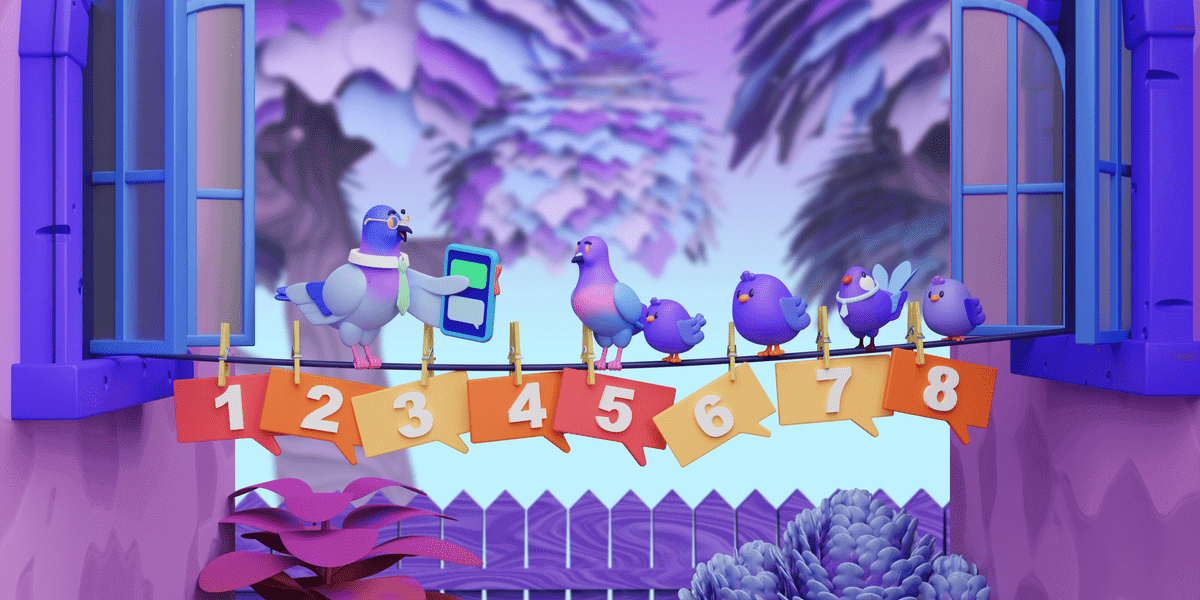
Table of Contents
What is downward communication?
Downward communication, also known as top-down communication, is the vertical process of sending a message or passing a piece of information down the hierarchical ladder. Simply put, downward communication flow takes place whenever a person in charge communicates a message to the people in a lower-level position, such as managers. Managers’ task is to transmit the same message to their team members. The message has reached its final destination when the lowest member of the hierarchical ladder is informed about it.
This type of communication flow usually follows a strict hierarchical structure, similar to a pyramid. Even though it might seem like an unnecessarily rigid communication process, especially in our era of information flow, downward communication has its practical use.
What is the purpose of downward communication?
Imagine having to inform your employees of the changes to the vacation policy. Your workday is hectic as it is, and having to schedule a conference call with each employee is out of the question. Asynchronous communication tools do come in handy, however, the rules regarding the vacation days differ for each employee, and it’s nearly impossible to put them in writing either. If only there was a way to inform a couple of people and further delegate the rest of the process. Downward communication, as a matter of fact, allows you to do just that.
Opting for downward communication proves helpful whenever there’s a need to promptly let everyone in your organization be aware of a particular matter. From clarifying goals, sharing instructions, and reports to introducing changes, downward communication flow is similar to a multifunctional tool that never fails, if handled with care.
How is downward communication different from upward communication?
Although both communication types fall under the vertical communication category, the direction of the communication processes is different. As opposed to the downward communication flow that goes down the vertical axis, from top management to the lower-level employees, upward communication involves employees’ communication with their superiors.
Unlike upward communication that comes in all shapes and sizes, from soliciting feedback, sharing opinions to offering fresh ideas to the management, downward communication is usually more directive and instructional.
💡 To find out all there is to know about upward communication, don’t miss out on our blog post: Upward communication: what it is and how to foster it in your team.
Examples of downward communication
Downward communication is an almost inevitable interaction type that you will encounter in a business environment. Let’s take a closer look at how it looks in practice.
🔸Downward communication that includes introducing changes
Turning over a new leaf is not uncommon in a business setting. You carefully plot a strategy, and after a project falls through, you decide to take a new direction or abandon the idea altogether. Communicating change, on the other hand, doesn’t always turn out the way you expected. When you decide to share such information in a meeting, you risk your information passing unnoticed. After all, Atlassian’s infographic shows that the average meeting goer isn’t as focused as we might have expected. Your team members sometimes do other work, daydream, or even sleep during a call instead of focusing on what’s being said. Therefore, it’s always better to put your words in writing, just in case.
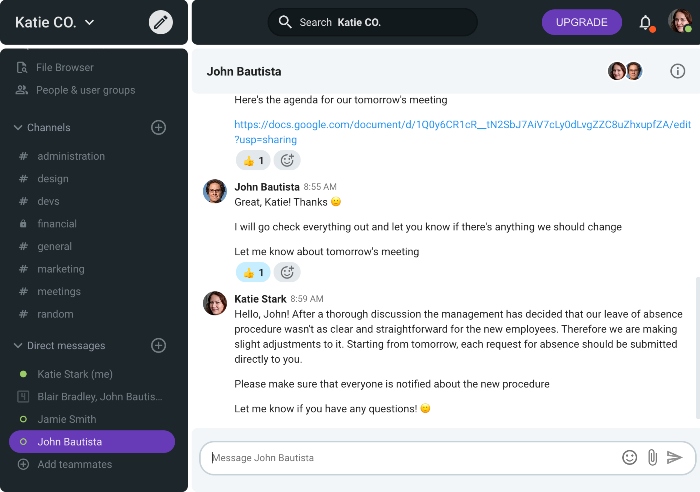
Sending a direct message in a business messaging app such as Pumble to the person in charge (such as a team leader or a manager) is a great strategy to communicate changes, and rest assured that the information will remain in one place. After they are notified about the change, they can pass the information further. This is how the manager in charge decided to inform their team members of the newest procedure.
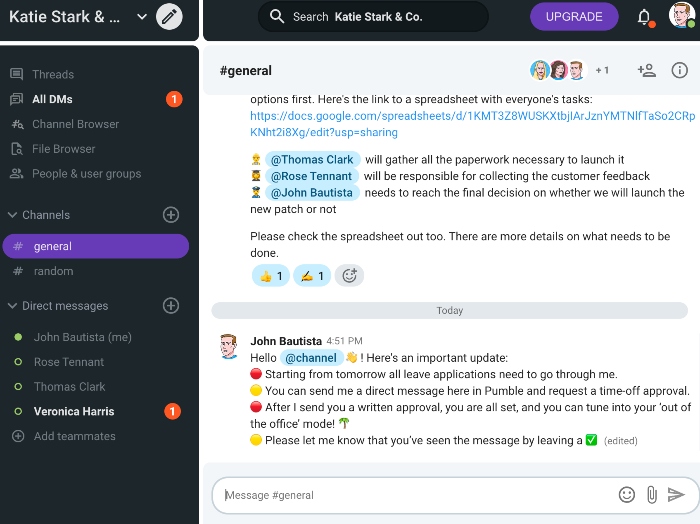
As seen in the example above, the manager decided to let the rest of the team know about the change by posting an announcement in their team chat app. Notifying the entire channel, he made sure his message didn’t pass unnoticed, and everyone was timely informed.
🔸Downward communication that includes clarifying the company’s goals
Transparency in workplace communication is one of the essential factors contributing to a healthy and thriving work environment. However, clear communication and the availability of all information always start from the top. Managers are there to ensure effective team communication and promote an environment of equal participation. To set up such an environment, it’s necessary to inform and remind the employees of the company’s goals every once in a while. Perhaps you have already introduced some changes to your business strategy, which brought upon certain modifications to your overall goals as well.
Downward communication eliminates the possibility of your team members feeling lost and keeps everyone on the same page. You can always opt for a quick update call or sharing your new strategy in your team’s #general channel.
🔸Downward communication that includes sharing updates
Your business doesn’t necessarily have to be as busy as a beehive to reach out to your team members with the latest updates. Sharing reports, feedback or newsletter assures your employees’ alignment and promotes transparent communication. Since shedding light on the company’s latest news always begins with the person in charge, it’s a perfect example of the downward communication flow. Whether it’s in the shape of a newsletter, a quick announcement in the team chat app, or a chart, making good news public starting from the top is an excellent way to show recognition or keep everyone in the loop.
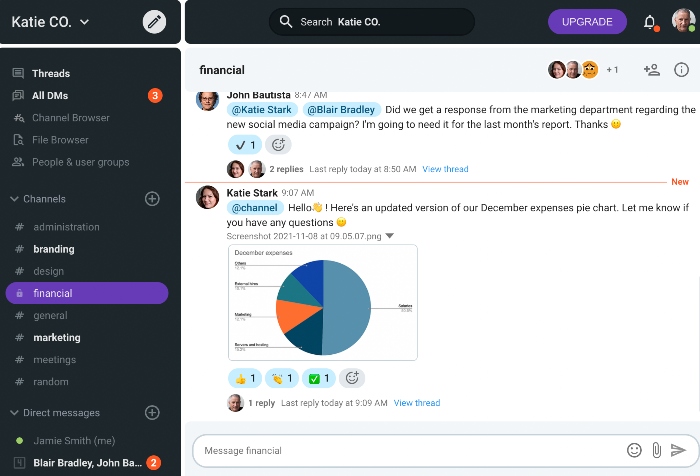
Making a visual and sharing it in your employee’s preferred communication channel is a great way to pass the information down and retain everyone’s attention on the information you shared. Research has shown that combining information with illustrations helps to understand and memorize information since our thinking process depends on verbal and visual cues. Therefore, whenever you fret about your team brushing aside a critical report, a simple chart will take a weight off your mind.
🔸Downward communication that includes explaining procedures
Although celebrating the company’s success and progress doesn’t do harm, other situations call for a more instructive approach. Sharing instructions, guidelines, and procedures falls under this category. Whether you have just welcomed new hires onboard or specific departments need clarification on the new policy, downward communication is the right interaction to go for.
Operational procedures and rules always come from the organization’s top, and communicating them should follow the same pattern. However, this doesn’t necessarily mean that every time a new hire signs a contract, you are supposed to elaborate on the entire company’s structure in real-time. Creating a guidelines document or an organizational chart speeds up the day-to-day operations of lower-level employees and helps keep confusion and mishaps at a distance.
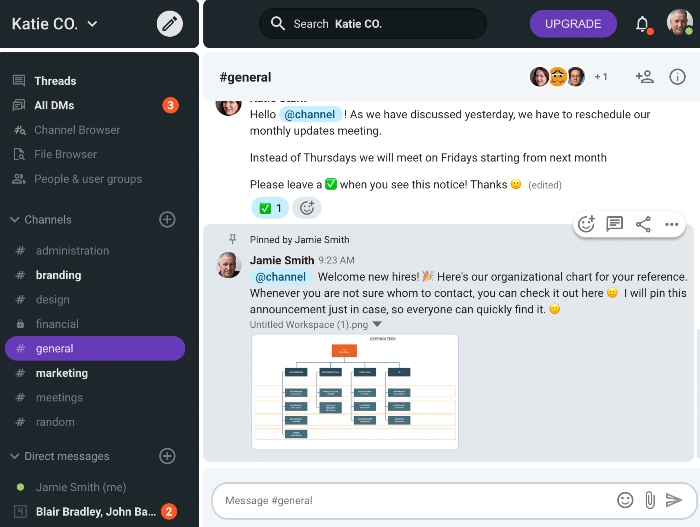
Advantages of downward communication
Apart from preventing the employees from scratching their heads whenever a new task comes up, an effective downward communication process can reduce the chances of information overload in your team. Going over all the benefits you can reap from this type of interaction will clearly show why carefully plotting your downward communication could be worth your time. From a quick delegation of responsibilities to increased efficiency and faster problem-solving, downward communication assists you in establishing the most efficient workflow. In case you still have your doubts about its value, let’s take a closer look at all the advantages of downward communication.
Downward communication helps you delegate responsibilities
A one-man show never goes well with effective workplace operations. A Gallup study found that managers expecting to accomplish everything on their own more easily lose their focus from the company’s growth and contribute to their employees’ frustration levels.
Instead of adding to the harmful do-it-all-by-yourself mentality, a proper downward communication process helps you delegate essential tasks. Passing the information down the company’s ladder also assists you in creating a healthy environment. Through downward communication, it becomes much simpler to distribute and systematically assign work. As a person in charge, your only task is to inform the managers of a project that needs to be put in motion, and you leave the rest of the strategy up to them. The managers then participate in the task distribution process, informing the rest of the team members and delegating the assignments.
Downward communication increases efficiency
With employees being well-informed about all the procedures and rules relevant to the organization’s day-to-day workflow, no time is wasted running around in circles searching for the information. However, for the information to contribute to the employees’ efficiency, it needs to be structured appropriately. It’s not enough to engage in an informal hearsay discussion or expect the team members to let each other know about overtime pay calculations or the procedure for soliciting feedback.
Unsurprisingly, employees value the words coming directly from their superiors and are more likely to tackle the task they consider attuned to their boss’ opinion. Therefore, when you practice downward communication to keep employees in the loop with the necessary data, you also give them enough guidance to focus on their best work.
Downward communication enables quick problem-solving
With all the clarity stemming from the higher-ups’ passing down their ideas and information and delegating responsibilities comes a transparent workflow. When the information flow follows a gravity-like pattern, everyone from the chain of command is aware of their responsibilities.
Let’s say that your departments are collaborating on a rebranding strategy. You have already informed the managers that their teams’ propositions are due in a month, but the design department didn’t submit their ideas. The deadline breach is clearly a consequence of the lack of communication between the team manager and the designers. However, the clear structure of passing the message down allows you to pinpoint the communication break easily and find the solution quickly.
Disadvantages of downward communication
Despite the obvious benefits that downward communication brings to the employees’ overall performance, from time to time, the effort of dispatching a message down the chain of command falls short. Let’s look at all the potential drawbacks of downward communication so that you can ward them off before they take the best of your communication flow.
Downward communication opens the door to misunderstandings
Sending a message to your subordinates and keeping your hopes up that it will arrive in one piece is sometimes the best you can do when practicing downward communication. The problems arise when this procedure transforms into a game of Chinese whispers. You try your best to keep the team leaders up-to-date with the company’s strategy, yet, somehow, your message gets distorted until it reaches the lowest-level employees.
Regardless of how clearly you think you communicated the information, it can always get misinterpreted. As Remy Blumenfeld explained for Forbes, people most usually interpret a message they hear according to their own needs and expectations. A simple statement such as “I will be late for work tomorrow” can be understood in many different ways. One coworker might infer that you have some personal things to attend to, others could think that you are just lazy and like to sleep in. Due to our reliance on the need filters in communication, not everyone will be able to hear your message the same way you intended it to be heard. Imagine how many filters the same information goes through when you send a message down the vertical axis of your company. No wonder it’s so challenging to keep everyone up-to-date.
Downward communication could delay your message
Despite the logic behind this strict procedure of downward communication, when the transmission depends on several people, there’s always a possibility for a delay. Perhaps the team leader intended to post an announcement in their team’s Pumble channel, but they got distracted by an important email. After responding to an email, they went back to completing this month’s report, and your important notice just slipped their mind.
Regardless of the clarity that downward communication brings to the table, if it requires days for an important notice to reach all the employees, this type of interaction does more harm than good. When this happens, the delayed announcement could even stop being relevant when it reaches its final destination.
Downward communication doesn’t make room for feedback
The one-way direction of downward communication sometimes looks like rolling a giant snowball down a hill. Forcing it downwards poses no problems, but if the people under the hill try to move the snowball back to the top, they are in for a herculean task. The same applies to obtaining feedback from lower-level employees. Procedure-like, such as it is, downward communication is excellent for instructions and labor division, but it leaves little room for direct contact between the upper management and their subordinates. During the process of passing the information down, the first-hand reaction always remains out of sight for the person initiating the information flow.
5 Tips on how to make downward communication successful
As we’ve seen, there’s a fine line between bossing around and providing valuable information with all the rules and instructions being issued from the management. However, practicing downward communication doesn’t have to be the cause of eye-rolling if implemented correctly.
Let’s see 5 tips on how you can make downward communication work for you like clockwork.
1. Encourage asking questions
Whether or not you are used to trying to complete all the crucial tasks yourself, dispatching information down the chain of command, and wondering whether it will arrive intact can be agonizing. Moreover, with every word we utter, there’s always a probability that something could be misunderstood, regardless of the number of people involved in a discussion.
Similarly, downward communication appears to be the root cause of all misunderstandings due to the number of ears involved. However, the fact that the message needs to travel down the ladder doesn’t need to pose a threat to the information. Fostering an environment where asking for clarification is welcomed and encouraged can help in preventing frequent misunderstandings.
Whenever you issue an important announcement that needs to be passed down, always try to set time aside for asking clarifying questions. The opportunity to ask for elaboration can remove any uncertainty from what’s being said and minimize the chances of your employees having to read between the lines to see your point.
2. Store the information
On days when you have so many things on your plate that you barely have time to spare a few minutes for a quick call, the information you share will most likely end up at the mercy of your coworkers’ memory span. Instead of relying on your team’s ability to keep all the data in their minds, it’s always better to put your words in writing.
If the reason behind your conference call was the delegation of responsibilities, you could always opt for a quick memo in your team chat app. Whenever there’s a change to the company’s formal procedures and policies, you can always create a separate document to store all the adjustments in one place. Allocating time to create an employee handbook or an organizational chart can make the process of downward communication as efficient as possible. Given that you can edit and share the documents and visuals as many times as you wish, the process of sharing the information becomes almost automated and leaves little room for losing the grip on the important data.
3. Be clear and informative
Encouraging your employees to ask questions and seek clarification is crucial for an effective communication process to take place. However, when their questions come rain or shine, and the ping of your team’s messages sabotages your workflow, it may be due time to assess your words. If you are prone to using business communication phrases such as jargon, clichés, or sentence fillers, not only do you risk the information you share being misunderstood, but you also undermine your own expertise by using vague and empty phrases.
Yet, there are some practical ways to guard against the danger of being misunderstood. Kimberly Janson, a Forbes Council Member, shares that whenever she’s in doubt on whether her audience will understand her message, she asks herself two things:
“Is it short enough to put it on a bumper sticker?”
“Would my 95-year-old mother be able to understand this?”
By analyzing Janson’s advice, it becomes clear as day that the best path to take when you decide to pass the information down is to try to keep things simple. After all, regardless of the complexity of the message, avoiding corporate buzzwords and department jargon does not put the meaning at risk. Quite the opposite, the moment you make your words plain and simple, the true meaning behind your information comes to light.
4. Understand the information first
Perhaps the information you are planning to share with the employees is the new policy on salary increase devised in collaboration between the HR and the Finance department. Although you are the person in charge, it’s not necessary for all the matters to be within your area of expertise. Whether you are supposed to approve the policy first or begin its implementation by announcing it to the managers, make sure to understand it thoroughly. Maybe the employees will have the same questions you do regarding the new policy, so it’s never a bad idea to ask for clarification before you decide to put it into words yourself.
5. Make honesty your best policy
Communicating in a gravity-like direction sometimes puts you at risk of being a bearer of bad news. However, if you embrace this role without a carefully thought-out plan of communication, you run a risk of grapevine communication becoming the leading stream of your business discussions. When the employees sense a crucial change is around the corner, but don’t have ample details on the issue they fret about, they are more likely to turn to guesswork and gossiping.
To prevent the speculation from escalating, always go for honesty. Being transparent and open in communicating change and negative outcomes is what guarantees your employees will stay with you through thick and thin. Apart from that, by eliminating suspicion from the table, you give your words greater value, further improving your downward communication flow.
Wrapping up
Humans requiring guidance and instruction is the tale as old as time. Yet, when the process of issuing guidelines is faulty, however useful it may be, the information hits a wall.
Employing downward communication sometimes implies sending a message down the chain of command and keeping your fingers crossed that all goes well. When this is the case, you risk your communication process going haywire. However, you don’t have to do it all yourself or boss everyone around to get through to employees.
By turning the pitfalls of downward communication to your advantage and plotting a top-to-bottom communication strategy, you get to reap the benefits of your improved communication process. So, after you announce an upcoming change or a new procedure, there’s not much more left to do but rest on your laurels while your message travels safely.




